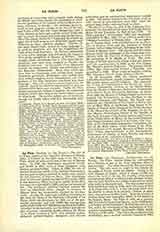

La Plata, DIOCESE of (DE PLATA)., The city of La Plata, capital of the Argentine Province of Buenos Aires, is situated on the right bank of the Rio de la Plata, about 35 miles southeast of the city of Buenos Aires. In 1895 the inhabitants numbered 45,410, and 80,000 in 1907, most of them foreigners, with Italians predominating. When, in 1880, the city of Buenos Aires was ceded to the Federal Government, the national Congress resolved to build a new capital for the Province of Buenos Aires. The foundation stone of this new capital was laid November 19, 1882; it was named La Plata, and grew rapidly in the 80’s, but came to a standstill in 1890, and has not recovered yet. The far famed artificial harbor assures the town an important future, though its nearness to Buenos Aires has temporarily checked its development. Among the important buildings belonging to the town are those of the National University of La Plata, which was developed, in 1905, out of the provincial university, and now (1909) has four faculties and a yearly budget of 1,080,000 pesos (about $440,000). Attached to the university are the library and university extension, containing 41,000 volumes, the Museo de la Plata, founded in 1877, with valuable anthropological, paleontological, zoological, and mineral collections, and an astronomical observatory erected in 1882. The parish church of San Ponciano, built in 1883, served as pro-cathedral until 1901, when the present large Gothic cathedral took its place.
The See of La Plata, by wish of the Argentine Government, was founded at the same time as the Sees of Santa Fe and Tucuman, by Bull of Leo XIII, “In Petri Cathedra“, February 15, 1897, and canonically established May 30, 1897, by an edict of Archbishop Udalislao Castellano of Buenos Aires. It is a suffragan of Buenos Aires, with jurisdiction over the Province of Buenos Aires and the Territory of Pampa Central, both of these formerly belonging to the Archdiocese of Buenos Aires. The diocese and the cathedral are under the patronage of the Immaculate Conception, while the Province of Buenos Aires is under the patronage of St. Martin of Tours. The Archbishop of Buenos Aires took charge of the new diocese until the appointment, in 1898, of the first bishop, Msgr. Mariano Antonio Espinosa. The present bishop (1909), Msgr. Nepomuceno Terrero y Escalada, was appointed in 1900. There is also an auxiliary bishop, Msgr. Francisco Alberti, titular Bishop of Siunia.
On December 29, 1909, the diocese numbered 1,700,000 inhabitants, mostly Catholics; 130 parishes; 260 secular priests and 60 religious. The communities of men are represented in the diocese by: Franciscans, Dominicans, Fathers of the Sacred Heart from the Diocese of Bayonne, Pallottines, Community of the Divine Word, Passionists, Salesians—to whom, since 1896, the Mission of Pampa Central has been entrusted (see Patagonia), 8 also Brothers of the Christian Doctrine and Marists. The female communities are: Daughters of Our Lady of Mercy, Sisters of Mary Help of Christians, Poor Sisters of St. Joseph of Buenos Aires, Sisters of the Divine Savior, of the Blessed Sacrament, of St. Anthony, of the Divine Master, Vincentians, Sisters of the Garden, of Our Lady of Lujar, of the Rosary (native and French), of the Child Jesus, of Mercy, of the Good Shepherd, Franciscan Tertiaries. Sisters of the Cross, of St. Camillus, of the Immaculate Conception, Capuchins, Sisters of the Holy Ghost, Little Sisters of the Poor, French Sisters of St. Joseph, Servants of Mary, of the Holy Union, Dominicanesses of the Annunciation, Franciscans of Charity, of Saint Martha, and Sisters of the Poor of St. Catherine of Siena.
GREGOR REINHOLD

